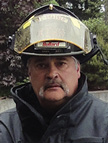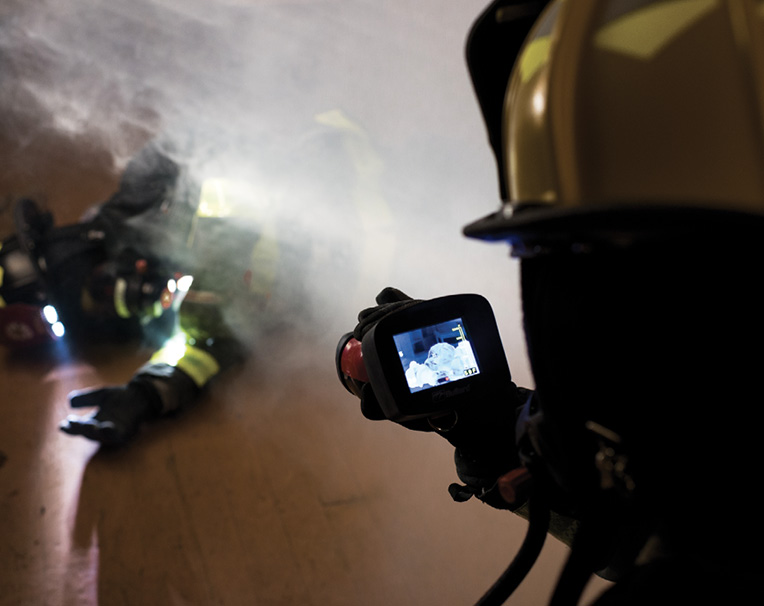
BY MANFRED KIHN

This month, I’d like to look at how far we have come in the thermal imaging (TI) world. I remember years ago, as I’m sure many of you do but don’t want to admit it, when I was first introduced to TI technology. Without a doubt, the TI camera is one of the most sophisticated tools in a firefighter’s arsenal.
Today, just about every manufacturer offers a TI for firefighting. Back when TIs first entered the market, there were not a lot of choices for firefighters. Most of the models were similar in design and features. With the emergence of new technologies, more manufacturers have entered the TI market with an array of models packed with innovative features designed to keep firefighters safe. With so many TI choices available today, it can be challenging to choose one that is best for your department.
Departments will have to do their homework so they can make an educated choice. Keep in mind that not everyone is going to agree on the choice. When deciding which TI to choose for your department, carefully review your needs along with cost, effectiveness, and safety. The number one choice for selecting a TI for your department is this tool’s ability to see in visible light-denied environments. This means seeing through smoke or other particulates and seeing in complete darkness.
TI technology has evolved beyond this basic benefit to provide sophisticated scene interpretation (helping firefighters understand heat layers and potential emerging threats), pinpoint where hot spots are located, transmit and record information for training purposes or for interpretation by others on scene, and even give directional guidance to a team moving through a structure. Today’s TIs are much more sophisticated, making it even harder to choose the right TI for your needs.
Several features offered on today’s TIs are valuable to firefighters, but beware of too many bells and whistles that might distract or confuse firefighters when in a hazardous environment. It’s easy to get caught up in the marketing of features, but an excess of features can just clutter the viewing image and take the focus away from the task. Always remember to keep your focus on your task and not on the tool.
Today’s Features
Let’s look at some of the features available on TIs. The smaller, less expensive TIs with limited features are used mainly for seeing through smoke and darkness. Firefighters who intend to use the TI as a basic tool will benefit from this model. Other TIs are designed to be used in the industrial setting to identify temperature differences that are low compared to the differences in temperature found on the fireground.
If you go up in price, you will find TIs equipped with an assortment of features and options with a much higher resolution for better imagery. These units are typically larger and heavier with bigger displays.

1 When evaluating TIs for purchase, be sure to do your homework so you choose the right one for your department. (Photo courtesy of Bullard.)
As the features and options increase on a TI, so does the price. Fire departments need to carefully consider the cost and complexity of the TI with potentially increased capability and performance to make an educated decision. Firefighters who are responsible for choosing a TI should also evaluate the model’s ergonomics and durability. For instance, how will the TI be used and by whom? Which criteria are most important to your department—size, weight, and customization? Don’t forget to ask the most obvious question, but a critical one: Can it withstand the harsh environment of firefighting?
I’ve been part of a selection team for a TI, and I can tell you that the range of experiences of the firefighters on the team often determine how smoothly the process goes. Whether a fire department has plenty of funds or a limited amount to purchase a TI, there will most likely be a divide between the younger, more aggressive firefighters and the more seasoned firefighters. It’s during this time that the homework you did in preparation for making a decision becomes critical information. Typically, you will find the younger firefighters gravitate toward the lighter, smaller TIs while the more seasoned firefighters like the heavier, larger models with the bigger displays.
On my selection team, one of the firefighters in the group advocating for smaller TIs researched the benefits of multiple TIs, citing decreased search times, lower costs, and a general higher level of safety. This research resonated with the committee members, and ultimately the department purchased two basic TIs instead of the one unit originally budgeted. This department selected what was best for its needs once it determined that having more eyes on the fire was the first priority in selecting a TI.
In contrast, I’ve seen departments purchase TIs just because they were the most expensive and had the most features. I’ve also seen departments purchase very basic products, only to be disappointed that what they presumed to be a standard feature wasn’t part of the package.
Just remember, when choosing a TI, what looks neat in the firehouse may not be so neat or easy to interpret when you encounter heat. It is always recommended that the mode named TI Basic, as outlined in National Fire Protection Association (NFPA) 1801, Standard on Thermal Imagers for the Fire Service, is used on the fireground. If you want to try a different mode, try it in the conditions in which you are expecting the TI to perform. As temperatures vary and increase, the usability of the mode will be impacted, along with the discernible details within the image. Not all manufacturers follow NFPA 1801 guidelines regarding making colorization translucent—some of those neat colors may block out important details such as victims, holes in floors, and more.
The selection process for a TI is not an easy or a simple task. TIs are tremendous tools when used to their maximum benefit. Fire departments that are making the important decision to outfit their operations with TIs should be well-educated and aware of their needs so the TI they choose is the right one.
Manfred Kihn is a 19-year veteran of the fire service, having served as an ambulance officer, emergency services specialist, firefighter, captain, and fire chief. He has been a member of Bullard’s Emergency Responder team since 2005 and is the company’s fire training specialist for thermal imaging technology. He is certified through the Law Enforcement Thermographers’ Association (LETA) as a thermal imaging instructor and is a recipient of the Ontario Medal for Firefighters Bravery. If you have questions about thermal imaging, you can e-mail him at manfred_kihn@bullard.com.

